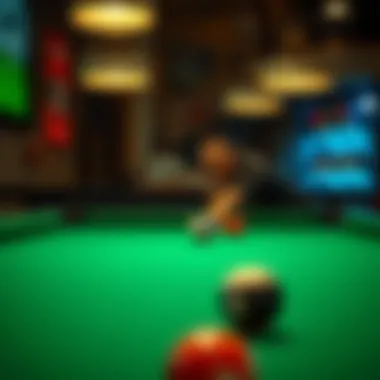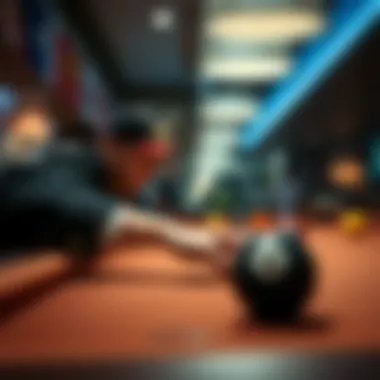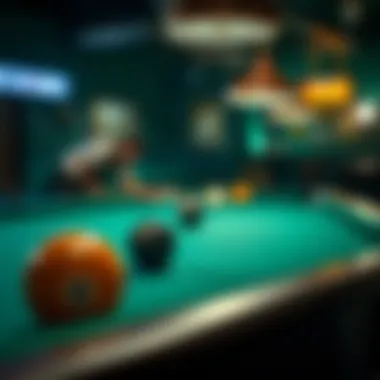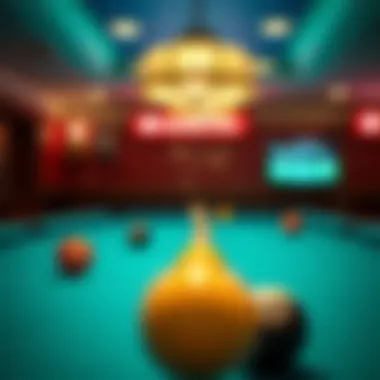Mastering the Long Line Technique in 8 Ball Pool


Intro
In the realm of 8 ball pool, understanding the long line technique can greatly enhance a player’s gameplay. This technique is not just a mere skill; it is a fundamental strategy that professionals and amateurs alike should familiarize themselves with. The beauty of this approach lies in its complexity and versatility—properly executed, it can lead to triumph in challenging circumstances on the table.
Much like a painter carefully digging deeper into the nuances of color mixing, mastering this technique involves more than just hitting the ball. It encompasses precision, focus, and an understanding of angles and alignment. When players get a grip on these elements, they don’t just play the game; they dominate it.
Throughout this article, we’ll delve deeper into the mechanics behind the long line technique. We will discuss how to apply this methodology in real-life scenarios found in any game of 8 ball pool, drawing on practical examples to better illustrate its application. Additionally, we’ll uncover common missteps players tend to make, offering insights to sharpen your control and improve your overall game.
By the end of this exploration, whether you're a novice hoping to build a strong foundation or an experienced player seeking to refine your skills, you’ll find knowledge that is pertinent and actionable. The road to mastering the long line technique isn’t straightforward, but with dedication and insight, it is certainly navigable.
Understanding the Basics of Ball Pool
To truly master the long line technique in 8 ball pool, a solid grasp of the game’s fundamental aspects is essential. Understanding the rules, objectives, and equipment of 8 ball pool sets a solid foundation upon which all advanced skills, including the long line technique, can be built. It helps players recognize the significance of each shot and how subtle differences in technique can influence the overall outcome of a game.
Game Objectives
The primary objective in 8 ball pool is to legally pocket all of one’s designated grouping of balls (either stripes or solids) and then pocket the 8 ball to win the game. Players alternate turns, aiming for precision and strategy in placement and shot execution. This objective essentially creates a strategic battlefield, where each shot can significantly impact the next. Understanding this objective allows players to focus not only on their shots but also on anticipating the opponent’s moves. It fosters a mindset geared towards not just personal improvement but also tactical awareness, which can be invaluable during tight match situations.
Equipment Overview
Pool Table Specifications
The pool table is the battlefield on which battles of skill are fought. Standard specifications include a table size of either 7 feet, 8 feet, or 9 feet in length. The most common choice for both recreational and competitive play is the 8-foot table. The size affects not just the gameplay dynamics, but also the player's strategies, particularly when employing techniques like the long line. A well-felt surface contributes to a more consistent ball roll, enabling better accuracy in shots. This quality facilitates players’ ability to practice and refine their skills, making it beneficial for mastering techniques like the long line.
Moreover, specific features such as the corner pockets and side rails are designed to enhance gameplay experience. Well-defined pockets ease the process of sinking balls while helping players learn angles, which is critical when executing longer shots. However, the dimensions can also serve as a disadvantage, as players must adjust their aim and force depending on the table size they’re using.
Cue Stick Selection
Choosing the right cue stick is another fundamental aspect of preparing to excel in 8 ball pool. The common length of cue sticks is about 57 to 58 inches, providing a comfortable reach for most players. The weight often varies from 18 to 21 ounces, which significantly influences how a player executes shots. A balanced stick is essential not only for control but also for delivering the necessary spin and speed for different shots.
Many players often gravitate towards custom or specialty cues, which provide additional benefits like enhanced grip and improved balance. For instance, a cue stick with a quality tip can make a substantial difference in how effectively a player strikes the ball. A hard tip generates more spin, while a softer tip allows for a smoother grip and more control. Choices made here have lasting impacts, influencing a player’s ability to execute the long line technique effectively.
Rules of Play
Basic Rules
An understanding of the basic rules underpins the entire game. Notably, players must strike the cue ball first and then the designated group of balls. Pocketing the 8 ball prematurely results in a loss, emphasizing the need for patience and strategic long-term thinking. Additionally, players can incur fouls by failing to hit the correct ball, not allowing the cue ball to reach a cushion, or missing entirely. Such rules reinforce the need for careful planning and shot execution, particularly pertinent when practicing the long line technique.
Fouls and Penalties
Fouls in 8 ball pool carry significant penalties that can shift the game’s momentum. For example, if a player scratches, or sinks the cue ball, the incoming opponent often gets ball-in-hand, allowing them greater opportunities for precise shots. Understanding these penalties cultivates a sense of caution and encourages players to refine their technique and decision-making skills. Recognizing the implications of these rules shapes a player’s approach to their shots, especially when incorporating the long line technique.
The Long Line Technique Explained
The long line technique is not merely a fancy term thrown around in pool halls; it's a fundamental aspect that can elevate a player's game to new heights. This technique emphasizes the significance of both precision and control while executing long-distance shots. Understanding the intricacies involved in the long line technique can lead to better shot selection and improved overall performance. It provides players with tools to assess angles, enhance their aiming ability, and build confidence in their strokes.
Definition and Purpose
The long line technique refers to the approach of creating a mental and physical straight line from the cue ball, through the intended target ball, and into the pocket. It serves a dual purpose: first, it aims to enhance shot accuracy by honing focus on the line of aim; second, it encourages players to develop consistency in their stroke mechanics, which is critical for success in 8-ball pool.
When players fully comprehend the long line technique, they can visualize their shots better—understanding how to align their bodies to reflect this imagined line. This visual and conceptual alignment is pivotal for achieving reliable results during gameplay.


Mechanics of the Long Line
Stance and Aim
The first step in executing the long line technique is establishing a proper stance and aim. A balanced stance, with feet firmly planted, allows players to maintain control and stability. What sets a beneficial stance apart is not only the distance between feet, but also the alignment of the body with the cue stick pointing towards the target. The feet should be shoulder-width apart, and the dominant foot should be slightly forward.
A key characteristic of aiming in this technique is the "eyeball to cue tip" connection, ensuring that the player's head is not tilted too far back or forward. This specific alignment allows for clearer sight lines as well as minimizing any unintended deviations during a shot. Neglecting stance can lead to significant errors, drastically decreasing accuracy.
Stroke Mechanics
Once the stance is perfect, focusing on the stroke mechanics becomes crucial. The stroke should be smooth and controlled, moving back and forth along the imaginary line. This element of the long line technique incorporates a consistent grip and a repeatable motion that maximizes power and precision without unnecessary flicks or jerks.
The influential part of stroke mechanics lies in its rhythmic quality—the tempo must remain steady to maintain flow from initiation to follow-through. A messy stroke often leads to unpredictability in where the cue ball ends up, disrupting the game plan and potentially leading to missed opportunities.
Strategic Importance
Positioning Your Shots
Positioning is not just about where the balls sit on the table; it involves anticipation and strategic foresight. Understanding where to set your shots becomes crucial, as it allows players to control the cue ball for their next maneuver. Effective use of the long line technique aids in visualizing these positions before making a shot, enabling players to plan multiple moves ahead.
A strategic highlight of positioning is how well players can utilize angles. By focusing on the long line principle, they can calculate the best trajectories to keep their games fluid and create more opportunities for themselves, resulting in better overall performance.
Enhancing Target Accuracy
Incorporating the long line technique amplifies target accuracy. By recognizing the alignment cues, players can see not just the ball they intend to hit but also how the cue ball will respond post-impact—where it will travel next. This foresight is vital for shaping the outcome of the game.
What makes this aspect beneficial is the confidence it instills in players. When they can control their aim and predict outcomes, they will likely perform better under pressure. However, neglecting accuracy can invite disastrous results, leading to missed shots and missed wins.
"Accuracy is not just a skill; it is a habit shaped by consistent practice and a solid understanding of technique."
Executing the Long Line Technique
Executing the Long Line Technique is key to blending strategy with execution in 8 ball pool. This technique emphasizes consistent practice and understanding the nuances of each shot. By focusing on the long line, players learn to develop better aim and shot alignment. The benefits are palpable with each hit that smoothly glides into the pocket, instilling confidence in one’s skills. Moreover, this approach encourages players to analyze their surroundings and rethink their overall gameplay.
Preparation Steps
When it comes to executing the long line technique, preparation is half the battle won. Careful configuration and analysis before making your shot can make a world of difference.
Analyzing the Table Layout
Analyzing the table layout plays a pivotal role in providing context to your upcoming shots. By taking time to inspect the position of the balls, you not only determine potential shots but also gauge the angles involved. The defining feature of analyzing the layout is its role in fostering strategic thinking. A keen player can spot opportunities or hazards that might otherwise be easy to overlook.
Moreover, understanding how the balls are clustered can reveal possible combos or breaks. This ability to read the table lends itself to better outcomes in matches, placing you in a position of advantage over your opponent. One unique aspect of table analysis is assessing the side pockets' accessibility. Being aware of how close or far the balls are can inform your cue ball positions later on.
Choosing the Right Cue Ball Position
Choosing the right cue ball position is another crucial element to executing the long line technique effectively. Proper positioning directly influences how you strike the target ball—essentially, it dictates not only the shot but also your follow-up options. A key characteristic to note here is that a well-placed cue ball can open up possibilities that may seem improbable otherwise. It’s like setting the stage for an artist to create their masterpiece.
The benefit of making a meticulous choice regarding the cue ball is that it can amplify the effectiveness of subsequent shots. A simple adjustment can enhance the precision of your next hit, setting you up for a series of successive successful attempts. On the flip side, poor positioning can lead to complicated scenarios where the chances of missing increase significantly.
Practicing the Skills
Once you grasp the fundamentals of preparation, practicing the skills is the next logical step. Regular drills can hone your technique and build muscle memory, which are essential for executing the long line technique efficiently.


Drills for Accuracy
Drills for accuracy are vital in refining your technique. These exercises often concentrate on making consistent strokes and developing a steady hand. Incorporating drills into your routine can sharpen your focus and improve your statistical shot success rate. This characteristic of accuracy drills lays the groundwork for reliable performance.
For example, establishing a set of target pockets and methodically practicing your shots towards them reinforces the skills needed for various game situations. One disadvantage, however, is the tendency of some players to skip basic drills, thinking they’re too advanced. But ignoring such fundamentals can result in shaky performance when the pressure is on during actual gameplay.
Feedback Mechanisms
Feedback mechanisms are integral in the learning process, allowing players to identify strengths and weaknesses. Engaging in discussions with fellow players, utilizing video analysis of one’s own gameplay, or simply seeking input can provide valuable insights. This feature of feedback is what cultivates growth and refinement in one’s techniques.
Moreover, observing noted professionals and analyzing their shot mechanics can vastly improve your understanding. However, relying solely on external input without self-assessment might lead to stagnation. Balancing feedback with personal evaluation creates a well-rounded framework for improvement in executing the long line technique.
"Success is where preparation and opportunity meet."
In summary, executing the long line technique in 8 ball pool hinges on careful preparation followed by focused practice. Strategies such as analyzing the table layout, positioning the cue ball, and utilizing drills can significantly sharpen your game.
Common Challenges in the Long Line Technique
Understanding the common hurdles in executing the long line technique in 8 ball pool is essential for any player aiming for precision. These challenges can often seem like a small fly in the ointment, but they might just be the difference between sinking those crucial balls and missing your shot. By identifying and addressing these challenges, players can see a marked improvement in their overall gameplay.
Identifying Mistakes
Mistakes can creep in when you least expect them. In the heat of a game, it’s easy to overlook the finer details that play a significant role in performance.
Poor Stance and Balance
The first critical aspect to consider is poor stance and balance. Beginners often stand in a way that’s less than stable, which can cause all sorts of complications during a shot. A well-balanced stance is foundational in this sport. Without proper balance, even the best aim won’t save you.
One key characteristic of a poor stance is feet being too close together or misaligned. This can lead to shaky hands and an unstable shot. Each player has a unique feature to their stance that suits their style, but a basic foundation should never be overlooked.
Advantages of addressing stance: Solidifying a balanced posture can significantly enhance shot accuracy. A well-spread stance allows for better rotation of the body during the stroke, contributing to a clean hit on the cue ball. On the other hand, it’s important to remember that over-correcting stance can lead to discomfort and lack of mobility.
Misalignment of Aim
Next up is misalignment of aim, another sneaky nemesis. This mistake might occur when a player focuses too much on pre-shot planning rather than ensuring that their cue stick is aligned with the target. The key characteristic here lies in the angle of the cue stick. A slight misalignment can translate into a major miss on the table.
For a competent aim, players should routinely check and adjust their cue positioning ahead of the shot. This
“final check” helps eliminate variables that can throw you off during execution. A unique feature of aim alignment is the mental note of where you wish to strike the cue ball, reinforcing visual cues that can lead to improved success rates.
Advantages of correcting alignment: Fixing this technical aspect can elevate one’s game dramatically, leading to fewer missed shots and improved confidence. The downside? A preoccupation with alignment can lead to overthinking, which might hinder spontaneity in your game.
Adjusting Your Approach
Once you identify where mistakes are happening, the next logical step is adjusting your approach. This can involve fine-tuning aspects of your stroke and adapting to various table conditions to enhance your game even more.
Fine-Tuning Your Stroke
Fine-tuning your stroke is about finding that sweet spot where technical precision meets personal style. The importance of a well-executed stroke cannot be overstated, as it's pivotal in achieving that desired cue ball movement.
A key characteristic of stroke fine-tuning involves focusing on the backstroke and follow-through. Players may practice different strokes to uncover which blend of speed and control works for them. The unique feature here is the rhythm – a consistent tempo can help players deliver shots effectively.
Advantages of optimizing stroke: When you find a rhythm that works, your game will generally improve, elevating your confidence and execution levels. Yet, there’s a balance to maintain; overthinking your stroke can lead to inconsistency during tournaments or competitive play.


Adapting to Various Table Conditions
Finally, adapting to various table conditions is essential for long-term success. Each table brings its own quirks, which can vary from cloth type to how the balls behave. Understanding these nuances aids players in making quicker adjustments to maintain efficiency.
The pivotal characteristic in adapting is observation. Keeping an eye on how balls roll and react to your shots allows for informed decision-making. Players can also assess table conditions prior to starting their games, taking that extra time to gather crucial insights.
Advantages of adapting to conditions: When players can confidently adjust their techniques according to different table types, it serves to enhance overall adaptability in competitive settings. However, there is a risk; if one becomes too focused on conditions instead of their technique, their game can suffer as a result.
In summary, the long line technique can present challenges that can feel daunting at times. But by honing in on stance, aim, stroke, and adaptability, players can tackle these challenges head-on and see real improvement in their game.
Advanced Strategies for Mastery
Incorporating Psychological Factors
Focus and Concentration
Focus and concentration are at the heart of effective gameplay. These two aspects dictate how well a player can control their nerve, particularly when the pressure mounts during decisive moments. With focus, a player can zero in on the desired shot, while concentration helps filter out distractions, be it a bustling bar scene or the chirping of a phone. This mental clarity serves as a bedrock which allows players to execute their strategy without falling prey to anxiety.
The key characteristic of focus is its necessity during critical shots, making it a powerful asset during the long line technique. A player who can maintain this focus generally demonstrates stronger decision-making skills, maintaining an acute awareness of angles and trajectory. However, it may come as a challenge for some. Distractions in a bustling environment could easily throw off one’s rhythm, thus a player must develop tools or habits that enhance their ability to stay in the zone. Meditation, breathing techniques, and even visualization can be used to hone this skill.
Managing Pressure Situations
Managing pressure situations is another critical psychological element that can dictate success in 8 ball pool. When the stakes are high, some players crumble while others thrive. This composure is characterized by an ability to remain calm and collected, focusing on execution rather than the potential consequences of failure. Strategies like positive self-talk or setting small, achievable goals during the game can aid in managing pressure effectively.
The unique feature of managing pressure lies in adapting one’s mental framework to be more conducive to performance. Players often develop a routine that they use before important shots, such as taking a deep breath or visualizing the perfect shot beforehand. While this approach works for many, it also has its limitations. Relying too heavily on a routine may lead to feelings of unease if players miss a shot, disrupting the mental flow of the game. Therefore, it’s essential to adapt and flexibly adjust one’s strategies in different scenarios.
Utilizing Technology for Improvement
Video Analysis
Video analysis presents a modern way to refine skills. It involves recording your gameplay and reviewing it to identify strengths and weaknesses. This technological approach provides visual feedback that can be much clearer than mere self-reflection. Analyzing your stroke, stance, and shot selection allows for an objective assessment of your performance.
The key characteristic of video analysis is its ability to highlight flaws that might go unnoticed in real-time. For instance, players can pinpoint a slight misalignment in their aim or a hitch in their stroke. This method is powerful in this article because it combines the technical aspect of the long line technique with self-improvement. However, it does require time spent reviewing footage, which could feel daunting for some. Players must balance their practice time on the table with time spent in analysis for the best results.
Practice Apps and Tools
Practice apps have become increasingly popular among pool enthusiasts. These tools offer players a range of features that allow for structured practice. From simulating shot scenarios to providing feedback on performance metrics like accuracy and consistency, apps can significantly enhance a player's skills in a controlled environment.
The unique feature of practice apps is their accessibility. Players can engage with these tools at their convenience—whether at home or on the go. This flexibility means players can practice lines, angles, and strategies anytime, which is exceedingly beneficial for skill retention. Despite their advantages, these applications do have a downside. Players may become too reliant on virtual practice, neglecting the feel of physical shots on a real table. Balancing app-based practice with table time is crucial for genuine improvement.
The End
Summarizing Key Points
In this article, we've peeled back the layers of the long line technique, highlighting its definition and purpose, as well as the techniques that go into perfecting it. Key points include:
- Stance and Aim: Proper positioning is foundational. A stable base helps in achieving accuracy.
- Stroke Mechanics: Understanding how to execute a fluid stroke enhances control over the cue ball.
- Common Challenges: Recognizing mistakes, such as poor alignment and stance, helps mitigate errors in play.
- Practical Drills: Regular practice, especially with drills designed for accuracy, is crucial for skill development.
These takeaways offer a clear roadmap for players to assess their ability and focus on areas that need improvement.
Encouraging Practice and Patience
To climb the ranks in 8 ball pool, players must embrace a mindset of continuous improvement. Practice is not just about repetition; it’s about deliberate practice where each shot is approached with purpose. Patience is equally important; mastery doesn’t come overnight. Allocate time for personalized drills and seek constructive feedback.
"Even the most talented players were once beginners; learning takes time, so don't rush the process."
Players should also consider setting realistic goals, breaking down the skills needed to apply the long line technique. With each session at the table, focus on one aspect at a time - whether it's refining your stroke, improving aim, or even developing a better stance. Remember, every expert was once a novice who didn’t give up.
In summary, the long line technique is a critical aspect of gameplay in 8 ball pool that can elevate any player’s performance. Embrace the journey and continually refine your skills; the effort will pay off in the heat of competition.



